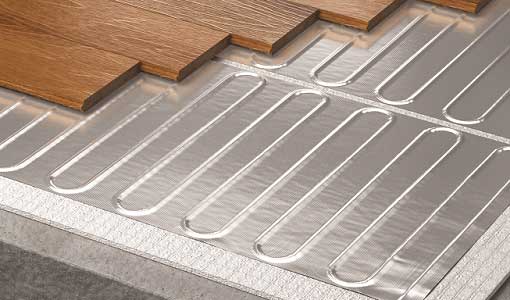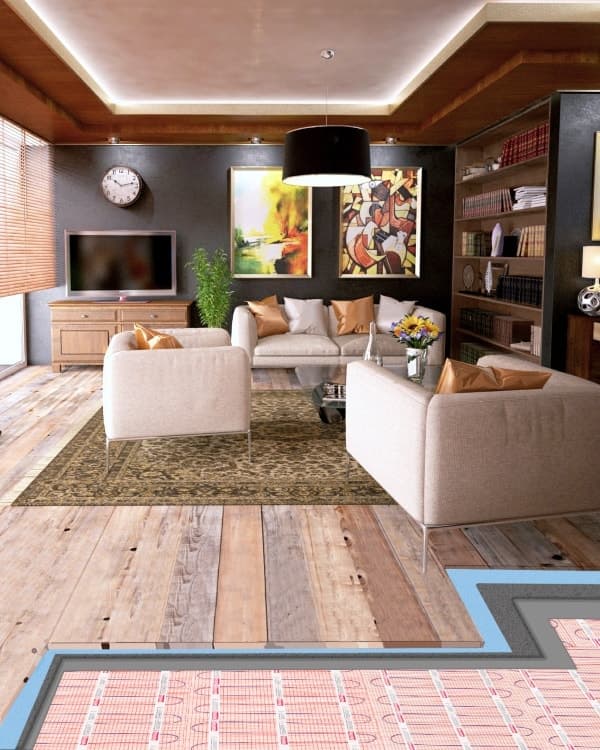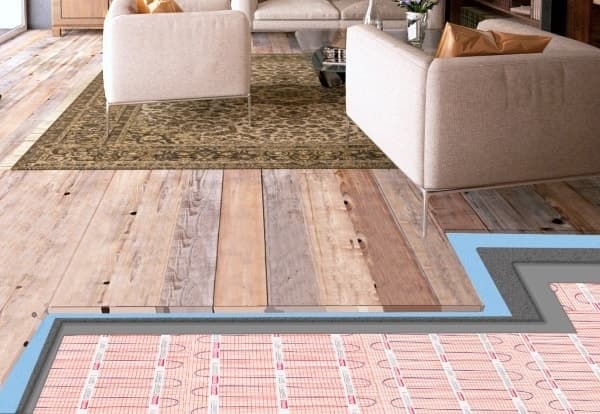Laminate Floors
Warmup electric floor heating systems can be used with laminate flooring. Our wide range of products ensure that you have the perfect solution for heating a laminate floor.
Electric floor heating systems for laminate
The most used radiant floor heating system for laminate floors is the Foil Heater. However, the best system for your project depends on the size of the room, floor height and many other factors. To help with deciding which system to choose, read our Buying Guide or contact us.

The Warmup Foil Heater is an electric underfloor heating system for laminateand other floating floor finishes. The Foil heater is made up of a fibre reinforced foil wrapped around a thin multi strand, dual core heating cable that is insulated with an advanced fluoropolymer. The foil provides a continuous earth layer within the floor construction whilst diffusing the heat away from the heating cable.
Electric floor heating systems for laminate
The most used radiant floor heating system for laminate floors is the Foil Heater. However, the best system for your project depends on the size of the room, floor height and many other factors. To help with deciding which system to choose, read our Buying Guide or contact us.

The Warmup Foil Heater is an electric underfloor heating system for laminate, engineered and other floating floor finishes. The Foil heater is made up of a fibre reinforced foil wrapped around a thin multi strand, dual core heating cable that is insulated with an advanced fluoropolymer. The foil provides a continuous earth layer within the floor construction whilst diffusing the heat away from the heating cable.

Thermal Conductivity of Laminate
When choosing the laminate flooring ensure that the material is as dense as possible for good thermal conductivity. The denser the material, the better it transfers heat. Also, the thinner the flooring material and the higher the density, the shorter the heat-up time and more responsive the underfloor system will be.
Floor Thickness
Both laminate and solid wood flooring make a good floor covering to go with underfloor heating as long as the wood is not overly thick. We recommend that wood or laminate thickness should be no more than 18mm as any thicker than this will hinder the efficient performance of the system. When it comes to the board width, wider boards will often show more “movement” than more narrow boards of the same material, so we recommend that the ratio of thickness to width should be in the region of 7 to 11. A board with a thickness of 16mm and width of 160mm would give a ratio of 10, so it is ideal.
Floor Temperature
Laminate and wooden floor surface temperatures should not exceed 27°C. This top temperature restriction is secured by using a thermostat which controls the heating system. If you are thinking of using floor heating as the sole/primary source of heat, get a heat calculation done to ensure that the floor heater will meet your heating requirement for the room.
Thermal Conductivity of Laminate
When choosing the laminate flooring ensure that the material is as dense as possible for good thermal conductivity. The denser the material, the better it transfers heat. Also, the thinner the flooring material and the higher the density, the shorter the heat-up time and more responsive the underfloor system will be.
Floor Temperature
Laminate and wooden floor surface temperatures should not exceed 27°C. This top temperature restriction is secured by using a thermostat which controls the heating system. If you are thinking of using floor heating as the sole/primary source of heat, get a heat calculation done to ensure that the floor heater will meet your heating requirement for the room.
If you need help with a heat loss calculation, our expert team is available to help you on 0345 345 2288.

Floor Thickness
Laminate flooring makes a good floor covering to go with underfloor heating as long as the material is not overly thick. We recommend that laminate thickness should be no more than 18mm as any thicker than this will hinder the efficient performance of the system. When it comes to the board width, wider boards will often show more “movement” than more narrow boards of the same material, so we recommend that the ratio of thickness to width should be in the region of 7 to 11. A board with a thickness of 16mm and width of 160mm would give a ratio of 10, so it is ideal.
Installation for Laminate Flooring
Installation of underfloor heating is dependent on the type of system. Foil Heater being a popular system with underfloor heating the installation will include:
- The type of underfloor heating
- Underlay
- Overlay
- Fitting the final floor covering
Underlay Thickness
It is good to note that everything above the heater, including underlay, overlay, and final floor finish needs to be in the limits set in the table below.
If the manufacturer of the laminate flooring states that it must be used in conjunction with an underlay, the underlay must be no more than 3mm – 6mm thick and breathable.
Limits of Heat Transfer
When using the system with laminate flooring, care should be taken to ensure effective performance of the system and we do not recommend installing a floor heater if the limits below are not met. This may hinder the performance of the system and result in the system not working as desired.
The figures below are for electric underfloor heating systems only. Water systems have a broader range of limits due to the variables of the specification.
| Transfer of heat limits | |
| Tog | 1,5 (Unless otherwise stated) |
| RSI | 0,15 m² K/W (Unless otherwise stated) |

